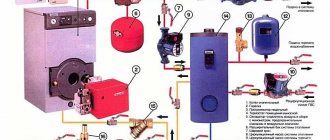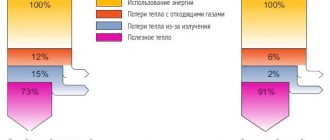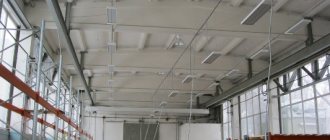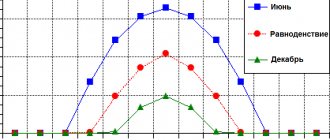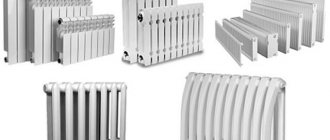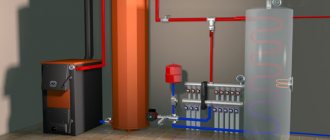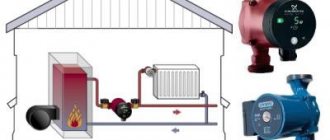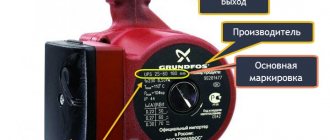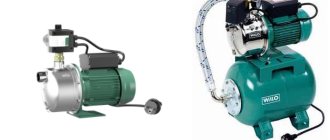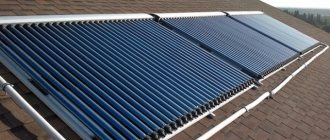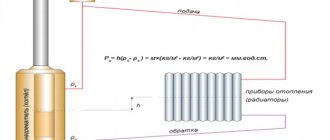Circulation pump in a gas boiler
The circulation pump in the design of a gas boiler accelerates the coolant through the heating system, due to which the coolant cools in the system more slowly and returns to the boiler in a “heated” form. Since heating in the boiler occurs to a certain temperature, the next heating cycle of the coolant will be shorter. This results in lower gas consumption and faster water heating cycles (higher efficiency).
It is believed that hydraulic heating systems do not require the installation of circulation pumps, however, it will not interfere at all in old heating systems with large diameter pipes.
By purchasing a gas boiler with a circulation pump in the design, you no longer need to install a separate circulation pump in the heating system.
Advantages of smart circulation pumps of the Evosta series
The Evosta range of electronic glandless circulators is designed specifically for residential heating and cooling systems. This is intelligently controlled equipment, characterized not only by improved operating parameters with minimal energy consumption, but also by ease of installation. Both the initial installation and the replacement of an outdated three-speed unit with a “smart” Evosta 2 or Evosta 3 will take a minimum of time and will not require complex tools or specific skills. Compact dimensions, a control board on the front part and a universal plug for the power cable contribute to ease of installation. The pumps are designed for integration into any heating (cooling) system, as they can operate in three modes.
- Constant speed mode – energy consumption is half that of conventional circulation pumps.
- Constant differential mode – for heated floors.
- Proportional differential mode – for systems equipped with thermal heads.
Technical characteristics of Evosta 2 and Evosta 3
- Temperature operating range: from -10 to +110 ˚С (Evosta 3 is equipped with a heat-insulating casing).
- Productivity: 0.4-3.6 m³/hour; 0.4-4.2 m³/hour.
- Pressure: up to 6.9 m; up to 8 m.
- Water protection class: IPX5.
- Energy efficiency degree: ≤0.18; ≤0.19.
- Overload protection: built-in.
- Air removal: inspection plug (not only gas removal, but also access to the shaft); automatic degassing through an air vent plug. For pumps of the Evosta3 series, a function is provided for releasing air from the hydraulic part “further along the line”, to the nearest air vent.
Pump control is as simplified as possible - one button for all settings, but Evosta 2 has three indicators to display the current status, and Evosta 3 has a more informative display with digital indicators for all operating parameters (mode, consumption, pressure, performance).
The durability of even the most advanced equipment used in engineering systems depends not only on its initial parameters, but also on the quality of the pumped liquid. To ensure that Evosta pumps last as long as possible, the manufacturer recommends using an additional device - a magnetic filter.
Alexey MareevTechnician at DAB
According to research results, the cause of about 70% of breakdowns and leaks of circulation pumps, as well as noise during system operation, is the ingress of iron compounds (magnetite, oxide) into the coolant. When using D.Mag magnetic filters, the impurity content is reduced by 90%. The use of magnetic filters reduces maintenance costs and allows the pumps to operate with minimal energy consumption.
Another new product that makes life much easier for both professionals and home craftsmen is GBM (quick assembly groups).
How to choose a circulation pump for heating?
We have decided on the type of circulation equipment. Now it’s time to pay attention to the performance characteristics of the circulation units, namely:
- On fluid flow in the system.
- On the working pressure (water column height).
In this case, by liquid flow we mean the minimum volume of coolant pumped through the boiler heat exchanger in an hour or minute. This characteristic is measured in m3/hour or liters/minute. Well, the working pressure is the maximum height of the water column “raised” vertically by the pump.
Moreover, the pump flow rate must correspond to the thermal power of the heating system, and the pressure must correspond to the length of the wiring. Simply put: one kilowatt of boiler power corresponds to a flow rate of 1 liter/minute. That is, a 25-kilowatt boiler must be paired with a pump that provides a flow rate of at least 25 l/min.
However, the indicated proportion - 1 kW: 1 l / min - gives only an approximate result. To more accurately determine the coolant flow (supply), European and domestic designers recommend using the following formula:
Р= (3.6 xQ)/(CхΔТ );
Where:
- P is the required flow rate,
- C is the coefficient of heat capacity of the consumed medium (water, oil, antifreeze),
- Q is the volume of the heated medium in the entire system,
- ΔT is the difference between the temperature at the outlet of the boiler and the inlet to the heat exchanger. Typically this parameter is 20 degrees Celsius.
The working pressure is selected according to the dimensions of the wiring - the length and height of the pipes in the system. Moreover, each meter of height must correspond to a meter of pressure. In turn, a meter of horizontal wiring is compensated by one decimeter of pressure (10 m: 1 m).
Well, the exact formula used by designers is as follows:
J= RLK;
Where:
- J is the desired parameter (pressure).
- R is the coefficient of hydraulic resistance equal to 100-150 Pascals per meter.
- L is the total length of the horizontal layout.
- K is the load increase factor, which increases the desired head by 200-250 percent.
Having calculated these parameters, we can select the “right” pump, the characteristics of which correspond to the calculated pressure and flow rate. However, focusing on the passport characteristics gives only an approximate result, fraught with the risk of purchasing an overly powerful device that serves a system with excessive agility.
Therefore, professional designers use a completely different approach to pump selection. They build paired diagrams based on the given parameters, determining the desired value at the point of intersection of the pressure and flow graphs. However, this technique is justified only if you purchase a truly powerful “dry” pump, designed to serve large rooms.
A “wet” type household unit can also be selected according to the passport data - such pumps do not consume more than 100-150 W, so serious errors in calculations are excluded in this case.
Features of modern heating systems
A water heating pump is a small device with an electric motor and an impeller that ensures normal coolant circulation in the system. In modern heating it is impossible to do without it - a large number of bends, a small clearance of plastic and metal-plastic pipes, as well as the small capacity of heating devices affect it.
This number of obstacles causes an increase in hydrostatic resistance in the heating system. The abundance of additional elements also has an effect - these are thermostatic valves, manifolds, hydraulic arrows and much more. Many problems are created by the desire to hide all the pipes in the walls so that only the radiators are visible from the outside - in this case, you cannot do without a water pump for heating the house.
Water pumps are in demand in closed heating systems. Here the coolant flows in a closed circuit without contacting the atmosphere. To install the systems, thin plastic pipes are used, so it is simply impossible to ensure normal flow of coolant here - it is necessary to install a water pump for heating.
Two pumps in the heating system or more
In order to ensure economical heating operation, we recommend purchasing more advanced energy-saving models of water pumps.
The water pump for circulating water in the heating of a private house is often not the only one in the system. Water-based heated floors have become a fashion in recent years. They provide heating for floor coverings, creating a comfortable atmosphere for people to stay. Since the basis for their manufacture is thin pipes made of cross-linked polyethylene, independent circulation of the coolant in them is impossible. Therefore, an additional pump is installed in the system.
Underfloor heating systems require the installation of a water pump. It is placed in the distribution box, next to the thermostatic valves, after which it must be connected to the mains. It works only in the underfloor heating circuit, while the second pump circulates the coolant through the rest of the heating circuit.
There are also diagrams of heating systems with several heating circuits. When planning to create independent heating for floors and rooms, consumers think about how many pumps are needed to heat a private home. One electric pump is installed here as a common one, in the supply or return, then a separate pump is installed for each circuit.
Types of antifreeze
Application of factory compounds
The range of antifreeze liquids for heating systems includes hundreds of items. But most often the compositions are produced in one of two forms:
Compositions for filling heating circuits are presented in a very wide range: there is plenty to choose from!
- Concentrates . Crystallization temperature -65 °C. It is assumed that before pouring into the pipes the composition will be diluted with softened or distilled water.
- Ready-to-use compositions that begin to freeze at -30 °C. You can immediately pour it into pipes and use it.
We ourselves can choose whether to dilute the concentrate or take a ready-made solution
If your priority is the minimum price, then you can dilute the finished composition by raising the crystallization temperature to -15...-20 °C. There is no need to dilute the antifreeze further: the loss of positive qualities will be very significant.
Ethylene glycol solutions are toxic but cheap
The market offers mainly glycol formulations - aqueous solutions of ethylene and propylene glycol. Their characteristics differ, and quite strongly:
- Antifreeze liquids based on ethylene glycol. They are quite cheap and effective, which is why they are very popular. The limiting factor is the toxicity of ethylene glycol. The composition cannot be used either in double-circuit systems (there is a risk of getting into pipes with hot water) or in open systems (toxic fumes).
For a double-circuit boiler, it is better to choose propylene glycol liquid
- Antifreeze based on propylene glycol. More expensive, but at the same time non-toxic, less aggressive to seals and metal components of the system. It can be used in double-circuit boilers, since its entry into the hot water supply system does not lead to negative consequences.
Photo of a heating element operating in a system filled with antifreeze
- Antifreeze. It is also essentially antifreeze, but it cannot be used in a heating system. The main problem is that upon contact with antifreeze, the elements of the heating system are very quickly destroyed.
Homemade water-alcohol mixture
When choosing which antifreeze is best to use for heating a private home, we must not forget about the alcohol composition. Its proportions can safely be called classic: 40% ethyl alcohol, the rest is distilled water.
Ethyl alcohol is quite expensive, but the roughest cleaning is sufficient for heating systems
Main advantages:
- Acceptable viscosity. Slightly higher than water, but significantly lower than glycol formulations.
- Less turnover. The water-alcohol solution has sufficient surface tension, so the risk of leaks at the joints is lower.
- Increasing the durability of pipes . Alcohol not only acts as a corrosion inhibitor, but also prevents the development of scale on internal surfaces.
Comparison of a pipe with ordinary water and a pipe after cleaning and filling with alcohol antifreeze
- Reduced expansion of water. Even if the pipe freezes through (this will happen at approximately -23... -25 °C), the ice plug will not put pressure on the walls from the inside, and the risk of a rupture will be minimized.
The use of hydroalcoholic “anti-freeze” is justified primarily in closed systems. But even in an open circuit, evaporation will not be so significant as to give up possible benefits.
Video on the topic
The boiler heats water, oil or antifreeze. The radiator transfers the energy of the heated environment to the heated room. The heating circulation pump pumps the heated coolant from the boiler to the radiator and removes the cooled medium back to the heat exchanger of the heating device.
Simply put: in a liquid coolant system, pressure equipment provides the very ability to “heat” the room. After all, without circulation, all the boiler power will be wasted - the hot coolant will not get into the batteries and will not return back for the next “warm-up”.
House heating scheme
Therefore, the selection of a circulation pump for heating must be done “wisely,” paying attention to both the performance characteristics of the unit and the reputation of the manufacturer of such equipment. And in this article we will look at the process of collecting pressure equipment, paying attention to some models of circulation pumps.
Types of pumps and their design
Heating circulation pumps consist of an electric motor with a rotor on which a wheel with an impeller is located. All this is housed in the case.
The body can be made from:
- Of stainless steel;
- bronze;
- brass;
- however, the most reliable ones are made of ceramic composite.
The vast majority of circulation pumps have a rotor-blade system. According to the operating mode of the rotor, pumps are divided into two types:
- With wet rotor;
- with dry rotor.
With a “wet” rotor
The motor and wheel are immersed in liquid, so water from the heating system reduces friction of moving parts and cools the engine. The stator is located in a stainless steel glass, which protects it from moisture.
Wet rotor pump design
These pumps have gained great popularity among owners of private homes for the following reasons:
- works almost silently;
- it is compact;
- reliable, does not need repairs for a long time.
The main disadvantage of such a pump is its low efficiency - from 30 to 50%.
It is strictly forbidden to turn on a “wet” pump without water! This pump should also not be used in drinking water supplies.
Prices for circulation pumps for “wet type” heating range from 2,400 rubles. up to 35,000 depending on features and region. (In Moscow, a good device can cost more than 100,000 rubles.)
With dry type rotor
The motor of such a pump is placed in a separate compartment, and the pump part is separated by a mechanical seal. The transmission of rotation occurs through the coupling. The efficiency of pumps of this type is very high - 80%. In addition, a “dry” unit will not burn out if it was turned on when there was no liquid in the system (although this is not useful for it).
Dry rotor pump design
However, there are also disadvantages:
- tendency to overheat;
- high noise level;
- big size.
The cost of a circulation pump with a dry rotor starts from 6,700 rubles.
It is most advisable to use a pump with a dry rotor where the pipeline is long and the noise from operation will not disturb anyone. For example, in centralized boiler houses.
Popular manufacturers and examples of the best pumps
The leaders in this segment are brands such as Grundfos, Wilo, NEOCLIMA, Wester and DAB. The most inexpensive products are sold under the brands Caliber, Belamos, and Gilex.
The Grundfos UPS series attracts with its versatility - it is capable of servicing different types of systems, including those connected to heated floors. The equipment is in particular demand among professionals - it does not emit a high level of noise, is characterized by low energy consumption and increased wear resistance. The pumps are sold in a high price segment, perhaps this is their only drawback.
Wilo centrifugal heating pump
The Wilo Star-RS line is a wet unit, has a built-in filter and manual rotation adjustment. The body is made of cast iron, the steel shaft is equipped with carbon bearings, and the impeller is reinforced with fiberglass. The models are attractive due to their easy installation and the ability to be installed in any position.
Gilex Compass pumps are characterized by a low noise level, they are highly efficient, and their power can be adjusted. It is important that these models can even serve pipelines with a small diameter.
DAB VA centrifugal pumps are actively being introduced into the engineering communications of two- and one-story country cottages. There are 3 operating modes, switching between them is done using a hand lever. Threaded connections facilitate installation; there is a built-in thermal switch responsible for current protection in thermal mode. The device operates almost silently - this is due to the special design of the rotor protective sphere.
Additional Information
Be prepared that some parts to repair the pump will be difficult to purchase.
They often cost so much that it is easier to buy a new unit.
The pump will last longer if the system is filled with antifreeze rather than water.
Special anti-corrosion protection will protect metal pipes, boiler and pump from scale. Just keep in mind that at low temperatures antifreeze becomes viscous. Whether this will damage this pump model - check when purchasing.
Do not attempt to repair the pump yourself until the warranty period has expired.
Modern heating systems are usually closed and with a pump. Some pyrolysis boilers have them built-in. But, even if your house has a classic stove with an open expansion tank, but the return water cools down greatly, the circulation pump can raise the temperature in the rooms! It is relatively easy to install and consumes much less electricity than, for example, an additional heater.
Water supply to a private home is an important component of comfortable living.
Pumping station - how to choose?
Read about the main characteristics of pumps and what you should pay attention to when purchasing.
You will learn about the types of storm drainage systems and the importance of their design in this article.
